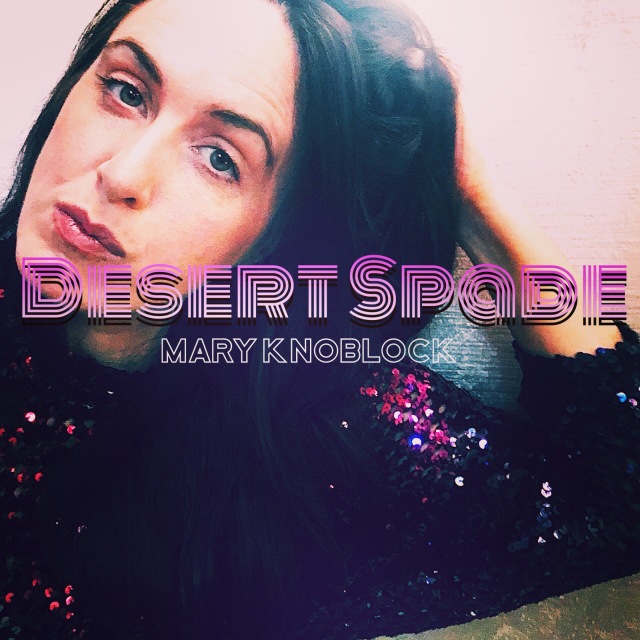
Mary Knoblock, a.k.a. DJ MEK, is an alternative electronica artist. Since 2016 she has been highly prolific, releasing seven albums in just two years. She followed up her debut Crystal Hallways with the albums Elevate and Champagne Socialists in the same year. 2017 saw the release of One Way, Heart Shaker and Crowns of Gold. This year has already seen the release of Zero to Sixty and now Desert Spade, her eighth album overall.
Consisting of eight tracks of between four to six minutes in length, it showcases the unique compositional method that Mary employs. It wasn’t a surprise to learn that she is also a painter and the technique of layering differing themes and melodies in this way is something she calls a ‘loopestra.’ It’s an apt phrase, as there is a strong classical influence in her work, a passion which she developed during her college years.
This more complex approach means her music stands apart from other electronica, as evidenced by the title track that opens the album. From the outset several different themes, all sonically and musically contrasting, compete for your attention. This would be distracting if it was not so well composed, with the main synth theme standing out amongst the atmospheric effects and chugging rhythmic synths that drive the momentum of the music.
The beat is itself intricate and layered with skittish hi hat patterns emerging at different points. The wealth of musical detail means you hear something new with every listen, not something you can say about most instrumental music.
Second track Blocker is a distinct contrast. It is rather more immediate in nature and at least starts out more simply. Based around two very catchy saw-wave synth riffs and a colossal beat that any hip hop group would be happy to have in their canon, this track is a very effective example of Knoblock’s ‘loopestra’ technique.
It is interesting how it employs repeating patterns yet the arrangement and musical soundscape is constantly metamorphosing so that there isn’t a dull moment. There is a lengthy breakdown section halfway through, which then introduces a funky horn line and it’s these influences from hip hop and soul that further enrich the music. This would be the ideal place to start with Mary Knoblock’s work.
Third track Lions is another six minute epic and, again, is very different to the previous track. It shows the classical influence once more with swirling harpsichord-esque arpeggios over a complex, syncopated beat in an unusual time signature. The last two minutes develop into a section of brooding piano chords which seems apposite for this enigmatic and intriguing track.
Fade is of a similar length but takes us to different pastures, musically. This one has a mesmeric quality achieved by pulsing synths repeating tight melodic patterns and an addictive use of rhythm. There are some really quirky synth riffs throughout that brought to mind the eccentric instrumentals of Todd Rundgren’s A Wizard, A True Star or the avant garde Hot Rats by Frank Zappa. An enjoyably crazy track.
Fifth track Queen of Diamonds is even further out there, with a magical, Eastern vibe. The triplet-infused shuffling rhythm provides the bedrock for one of the most evocative melodies on the album, a synth that sound like chiming bells. The second half has a truly transcendent quality with Knoblock conjuring a dreamy sonic landscape. Next comes the remix of Fade, which is an interesting reinterpretation of the original with a harder hitting beat and the version I prefer, personally.
Sail, the seventh track, is one of the more melodically complex pieces on the album, with a plethora of themes and riffs that cover the sonic spectrum. It starts with a minimalist approach to rhythm, with an off kilter tilt that made me think of Adamski’s electro-blues classic, Killer. It gradually progresses into a full beat and a fascinating exploration of the musical ideas that seeded in the first half.
Closing track King of Spades is equally complex but has a blissed out feel to it and a relatively simple four-to-the-floor groove. It passes through several stages of thematic development, almost like house music crossed with the structure of a classical fugato. It’s another fine example of the compositional and sonic possibilities that have been largely unexplored in electronica, making it an apt way to close the album.
Overall, this is a fascinating musical odyssey created by an artist who takes a unique approach to her art and breathes fresh life into the over saturated genre of electronica. By drawing on eclectic influences from classical to hip hop, she forges new sonic territory and opens up vistas of potentiality. I recommend this to all electronica/EDM fans, especially those who are tired of the homogeneous EDM in the mainstream and are craving something more substantial and adventurous.
VERDICT = 8.8 out of 10
Alex Faulkner
Listen here: